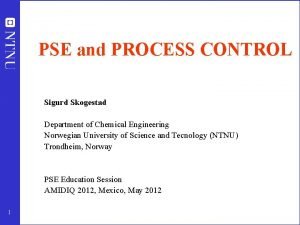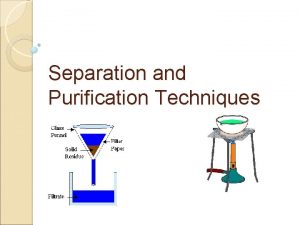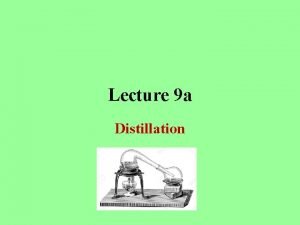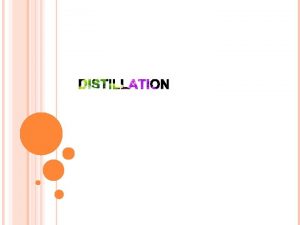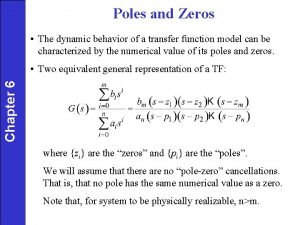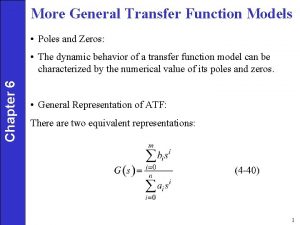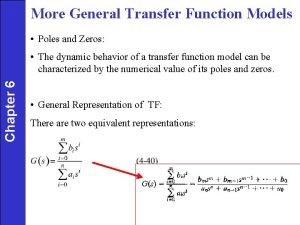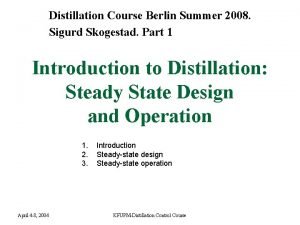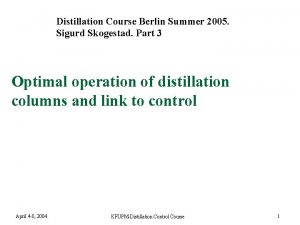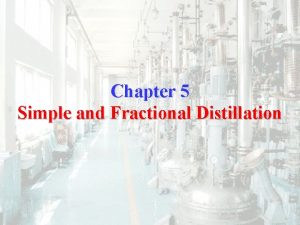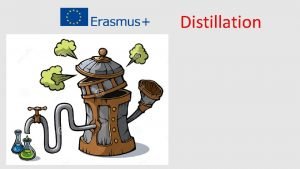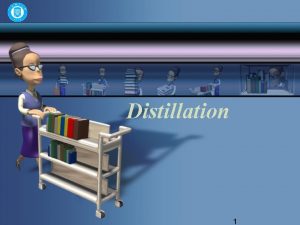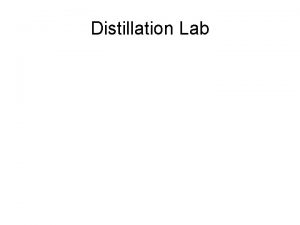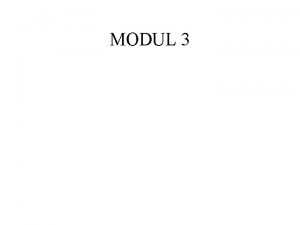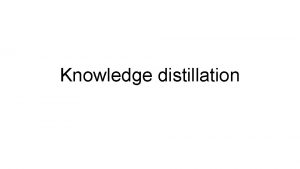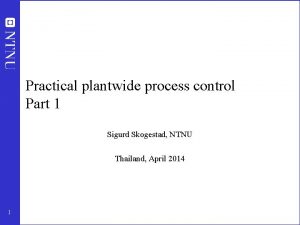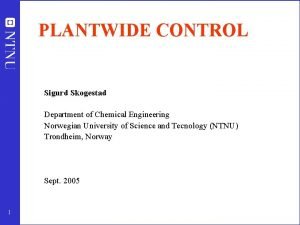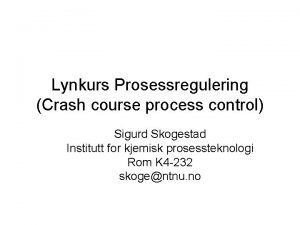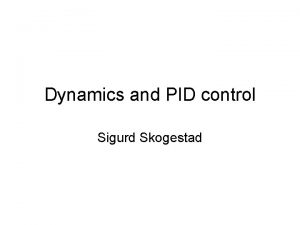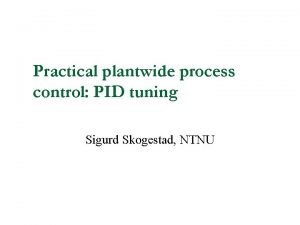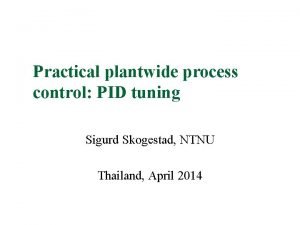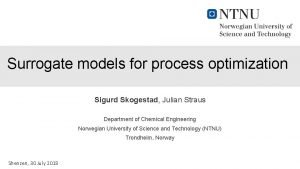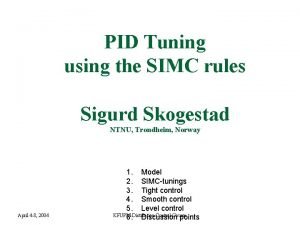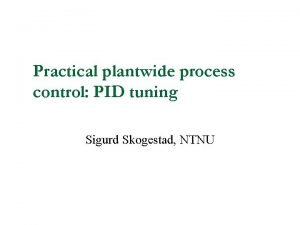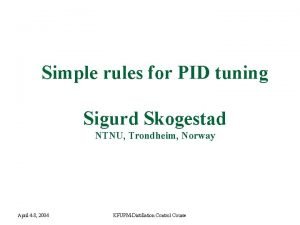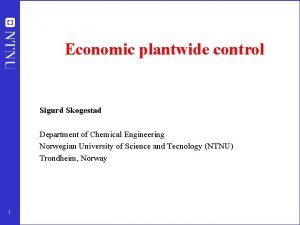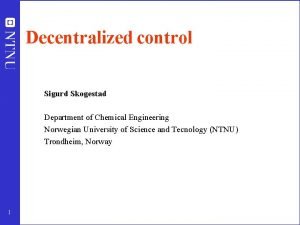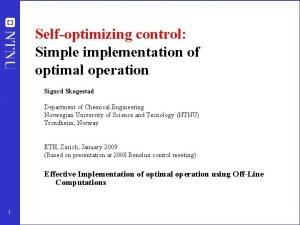Distillation is part of the future Sigurd Skogestad















































- Slides: 47

Distillation is part of the future Sigurd Skogestad, NTNU Mamaia, Romania, Sept. 2019

Outline 1. 2. 3. 4. 5. 6. 7. 3 Introduction. Importance of reflux Myth about distillation being inefficient Distillation unbeatable for high-purity separations Integrated schemes. Divided-wall / Petlyuk Multivessel batch distillation Adding a component to break azeotropes Control: Myth about slow response

1. Introduction Water distillation. 1483 1545 4 1512 1593

1972 5 What’s wrong?

Batch distillation in wikipedia (2019) V D L 6 Note: 1. Has column (multistage) 2. Has reflux

Good design • Packed column (about 10 stages) • Adjustable reflux 7

Strange design 8

Good design for tuica No column, no reflux 1 theoretical stage 9

Vapor-liquid equlibrium for ethanol-water 78. 4 C . 78. 1 C Y 1: in vapor Large activity cofficient: Ethanol really does not like water 100 C And water does not like ethanol -> low-boiling azeotrope X 1: Mole fraction ethanol (1) in liquid 10

Mc. Cabe-Thiele . Infinite stages: Azeotrope at Y=0. 92 (96 vol%) Y 1: in vapor 3 stages: Y=0. 70 (84 vol%) 3 2 stages: Y=0. 60 (77 vol%) 2 1 stage: Y=0. 35 (55 vol%) 1 X=0. 07 (14. 5 vol%) X 1: Mole fraction ethanol (1) in liquid 11

Finite reflux . Y 1: in vapor 3 stages: Y=0. 675 (82 vol%) 3 2 1 3 stages: Y=0. 35 (55 vol%) Diagonal: reflux ratio is infinite Blue line: reflux ratio is L/D=5 Red line: reflux ratio is zero (L=0) X 1: Mole fraction ethanol (1) in liquid 12

Reflux gives strange effects With fixed product rate (D): Must increase heat in the bottom to get lower temperature 13

2. «Distillation is an inefficient process which uses a lot of energy» • This is a myth! • By itself, distillation is an efficient process. • It’s the heat integration that may be inefficient. • Yes, it can use a lot of energy (heat), but it provides the same energy as cooling at a lower temperature 14

Thermodynamic (exergy) efficiency for conventional distillation • Thermodynamic Efficiency = Ideal work for the separation/Actual work: Approximate for 15

Peak efficiency is -ln 0. 5 = 0. 693 at z=0. 5 Comment: Above 50% for z from 0. 2 to 0. 8 α = relative volatility z = feed composition (mole fraction light component) 16

Thermodynamic efficiency of binary distillation • High efficiency at small z for easy separations with large α • Reason: Must evaporate light component to get it over top z = fraction light component in feed α = relative volatility 17

King (1971) Note: Non-ideality does not necessarily imply lower thermodynamic efficiency 18

Why is it not perfect – where are the losses? • Irreversible mixing loss at every stage. • Largest losses in the middle of each section – where the bulk separation takes place • Small losses at the highpurity column ends 19

3. Distillation is unbeatable for highpurity separations • α = relative volatility 20

4. Integrated / complex schemes can save energy and capital 21

Divided wall columns: starting to catch on • • • 1940’s: first patent 1960’s: Thermodynamic analysis (Petlyuk) 1984: First implementation (BASF) 2005: BASF has about 50 divided wall columns 2019: Several hundreds – also in Japan, South Africa, China. . . 22

Typical sequence: “Direct split” A B C A, B, C, D, E, F D E F 23

3 -product mixture A A+B A+B+C B+C B C C 1. Direct split 24 2. Indirect split A+B+C B B+C 3. Combined (with prefractionator) C

Towards the Petlyuk column A A A+B A+B+C B C 25 A+B+C A+B B B+C 3. A A+B+C B B+C C 4. Prefractionator + sidestream column liquid split vapor split C 5. Petlyuk 30 -40% less energy

GC – Chemicals Research and Engineering Dividing Wall Columns Off-center Position of the Dividing Wall ≈ Montz

4 -product mixture: Kaibel column A A A+B B (pure!) B ABCD A – methanol B – ethanol C – propanol D – butanol ABCD C C (pure!) C+D D Alternative 3 -column 28 sequence D Kaibel: 1 column!! More then 50% capital savings Also saves energy (but maybe not exergy)

Control of Kaibel column Close a “stabilizing” temperature (profile) loop for each split • Prefractionator: • Close 1 “stabilizing” temperature loop • Main column • Close 3 “stabilizing” temperature loops D 29

D S 1 H=6 m D=5 cm F S 2 B 30

5. For autonomous and energy-efficient batch distillation try multivessel distillation with closed operation 31

Closed operation of batch distillation Two-vessel Multivessel Closed Operation of Multivessel Batch Distillation: Experimental Verification Bernd Wittgens and Sigurd Skogestad. AICh. E Journal. 46 (6), pages 1209 -1217 (June 2000) 32

33

6. Azeotropes can be broken by adding extractive component and especially by making use of liquid-liquid splits 34

Solvent recovery. Explosives plant, Norway cooling N-butyl-actate 60% acetic acid Acetic acid 35 Water

oppstart i starten av desember 2018 (startet med 100% syre i kolonna) Temp plate 45 Temp plate 40 Flow Bu. AC Temp plate 35 (Sp = 117) Temp plate 20 Temp plate 15 Nivå dekanter Temp plate 10 (Sp=95, 5) Temp plate 5 Damppådrag Temp plate 1

02 feb. 2019. Siste kjøring før rep av kolonne Temp plate 45 Temp plate 40 Temp plate 35 (Sp = 117) Flow Bu. AC Temp plate 20 Temp plate 15 Temp plate 10 (Sp=95, 5) Damppådrag Temp plate 5 Nivå dekanter Temp plate 1

20 feb. 2019. Første oppstart (after Koch-Glitch repair) P = 100 min Temp plate 45 Temp plate 40 Temp plate 35 (Sp = 117) Flow Bu. AC Temp plate 20 Temp plate 15 Nivå dekanter Damppådrag Temp plate 10 (Sp=95, 5) Temp plate 5 Temp plate 1 Controller integral time for temperature loop = 10 minutes

Slow oscillations were caused by too slow control • • Tray 10 temperature controlled using butyl-acetate reflux: Integral time (taui) = 10 minutes. TOO MUCH INTEGRAL ACTION! Sigurd’s formula*: Increase Kc*taui by factor f = 0. 1*(P/taui 0)^2 = 0. 1*(100/10)^2 = 10. Problem solved by increasing integral time to 50 minutes. *Sigurd Skogestad. ''Simple analytic rules for model reduction and PID controller tuning'' J. Process Control, vol. 13 (2003), 291 -309 39

Drift juni 2019, 8 timers periode Temp plate 45 Temp plate 40 Flow Bu. AC Temp plate 35 (Sp = 117) feed kolonne Temp Ac. OH feed kolonne Temp plate 20 Discharge kolonne Temp plate 15 Nivå dekanter/kolonne Temp dekanter Damppådrag Temp plate 10 (Sp=95, 5) Temp plate 5 Temp plate 1

7. Better operation and control can improve quality and productivity S. Skogestad, “The dos and don'ts of distillation columns control”, Chemical Engineering Research and Design (Trans IChem. E, Part A), 85 (A 1), 13 -23 (2007). 41

Myth of slow control • Let us get rid of it!!! Compare manual (“perfect operator”) and automatic control for typical column: • 40 stages, • Binary mixture with 99% purity both ends, • relative volatility = 1. 5 – First “one-point” control: Control of top composition only – Then “two-point” control: Control of both compositions 42

Myth about slow control One-point control Want x. D constant Can adjust reflux L Disturbance in V “Perfect operator”: Steps L directly to correct steady-state value (from 2. 70 to 2. 74) 43

Myth about slow control One-point control CC x. DS Disturbance in V “Perfect operator”: Steps L directly Feedback control: Simple PI control Which response is best? 44

Myth about slow control One-point control 45

Myth about slow control Two-point control CC CC x. DS: step up x. BS: constant “Perfect operator”: Steps L and V directly Feedback control: 2 PI controllers Which response is best? 46

Myth about slow control Two-point control 47

Myth about slow control Conclusion: • Experience operator: Fast control impossible – “takes hours or days before the columns settles” • BUT, with feedback control the response can be fast! – Feedback changes the dynamics (eigenvalues) – Requires continuous “active” control • Most columns have a single slow mode (without control) – Sufficient to close a single loop (typical on temperature) to change the dynamics for the entire column 48

Conclusion • • • 49 Distillation is important Distillation is unbeatable (in some cases) Distillation is fun Distillation is complex yet simple Distillation is part of the future
 Pse in p&id
Pse in p&id Simple distillation boiling point difference
Simple distillation boiling point difference Toluene distillation under vacuum temperature
Toluene distillation under vacuum temperature Define distillation process
Define distillation process Sigurd meldal
Sigurd meldal Sigurd allern
Sigurd allern Sigurd allern
Sigurd allern Skogestad half rule
Skogestad half rule Skogestad half rule
Skogestad half rule Skogestad half rule calculator
Skogestad half rule calculator Future continuous and future perfect exercises pdf
Future continuous and future perfect exercises pdf Future perfect simple vs future perfect continuous
Future perfect simple vs future perfect continuous Future perfect and future continuous
Future perfect and future continuous Perfect future
Perfect future How to use present continuous for future
How to use present continuous for future Nulti i prvi kondicional
Nulti i prvi kondicional Present past future tense
Present past future tense Tense chart in english
Tense chart in english Future nurse programme
Future nurse programme Future continuous and future perfect
Future continuous and future perfect Future plans and finished future actions
Future plans and finished future actions Past continuous future tense
Past continuous future tense Tia chieu sa te
Tia chieu sa te đặc điểm cơ thể của người tối cổ
đặc điểm cơ thể của người tối cổ Các châu lục và đại dương trên thế giới
Các châu lục và đại dương trên thế giới Thế nào là hệ số cao nhất
Thế nào là hệ số cao nhất Tư thế worm breton
Tư thế worm breton Hệ hô hấp
Hệ hô hấp ưu thế lai là gì
ưu thế lai là gì Tư thế ngồi viết
Tư thế ngồi viết Cái miệng nó xinh thế
Cái miệng nó xinh thế Cách giải mật thư tọa độ
Cách giải mật thư tọa độ Bổ thể
Bổ thể Tư thế ngồi viết
Tư thế ngồi viết Thẻ vin
Thẻ vin Thể thơ truyền thống
Thể thơ truyền thống Các châu lục và đại dương trên thế giới
Các châu lục và đại dương trên thế giới Chúa sống lại
Chúa sống lại Sự nuôi và dạy con của hươu
Sự nuôi và dạy con của hươu Từ ngữ thể hiện lòng nhân hậu
Từ ngữ thể hiện lòng nhân hậu Diễn thế sinh thái là
Diễn thế sinh thái là Ví dụ về giọng cùng tên
Ví dụ về giọng cùng tên Vẽ hình chiếu vuông góc của vật thể sau
Vẽ hình chiếu vuông góc của vật thể sau 101012 bằng
101012 bằng Tỉ lệ cơ thể trẻ em
Tỉ lệ cơ thể trẻ em Lời thề hippocrates
Lời thề hippocrates đại từ thay thế
đại từ thay thế Quá trình desamine hóa có thể tạo ra
Quá trình desamine hóa có thể tạo ra
